Laboratory 18650 21700 26650 32700 Cylindrical Cell Making Machine Plant For Lithium-ion Battery Assembly Research
Contact Person:Louis Yang Email: Louis@chinabatterymachine.com Tel:+86 13003860308 Whatsapp: +86 13003860308 Wechat:18659217588
Email: Louis@chinabatterymachine.com
Tel:+86 13003860308
Whatsapp: +86 13003860308
Wechat:18659217588
Item No.:
LITH-PRCD1100Payment:
Credit Card, Paypal, T/T , Western Union, LCLead Time:
5 daysLab Lithium-ion Battery Powder Resistivity & Compact Density Analyzer For Anode and Cathode Material Testing
The significance of powder resistance
The rate performance of lithium-ion batteries is closely related to the battery resistance. The battery resistance includes ionic resistance and electronic resistance. The ionic resistance mainly refers to the resistance of lithium ions in the electrolyte in the electrode pores, the resistance of lithium ions through the SEI membrane, and the resistance of lithium ions and electrons. The charge transfer resistance of the active material/SEI film interface and the solid phase diffusion resistance of lithium ions inside the active material. The electronic resistance mainly refers to the resistance of the positive and negative active materials, the current collector resistance, the contact resistance between the active materials, and the contact resistance between the active material and the current collector. And the welding resistance of tabs. In the actual battery development and producti on process, the ionic resistance part needs to be evaluated at the finished battery end, and the electronic resistance part can be quickly evaluated at the material and pole piece end. Therefore, the accurate evaluation of the material and the electrode elect-ronic resistance is important for the battery. The resistance estimation is of great significance.
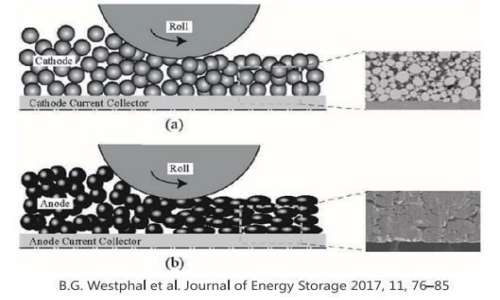
Measurement system analyze
Test condition: 5 samples, 3 operators, 3 times/pcs/operator
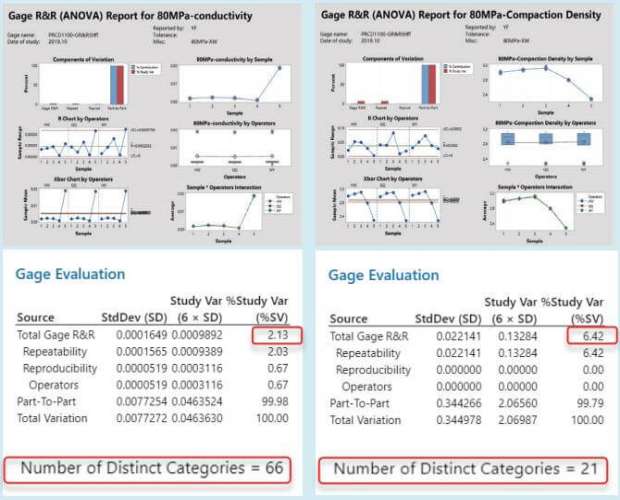
|
%GRR accepted rule |
%GRR<10% |
Excellent |
|
|
10%<%GRR〈30% |
Acceptable |
|
|
%GRR>30% |
Unacceptable |
|
ndc accepted rule |
ndc>10 |
Excellent |
|
|
5<ndc < 1 |
Acceptable |
|
|
ndc < 5 |
Unacceptable |
♦ Compact density : GRR-Excellent
♦ Powder Resistance : GRR-Excellent
Applications
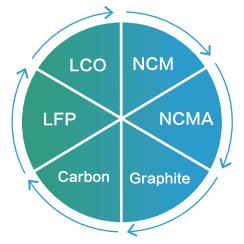
Application cases
1.LCO material assessment (evaluation of electrical properties of modified powder(LCO))
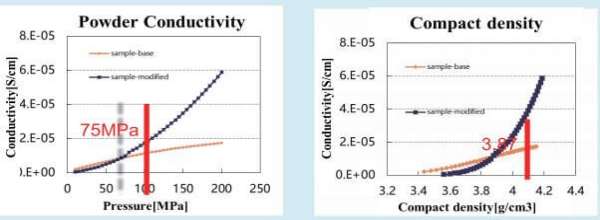
Parameter: 10-200MPa, 5MPa steps, keep 15s
Results: When the Compact density of the modified powder is greater than 3.87g/cm3 (applied pressure > 75MPa), the conductivity of the modified powder is greatly improved.
The effectiveness of the modification can be evaluated.
2.NCM material assessment (relation of powder resistivity and electrode: NCM material)
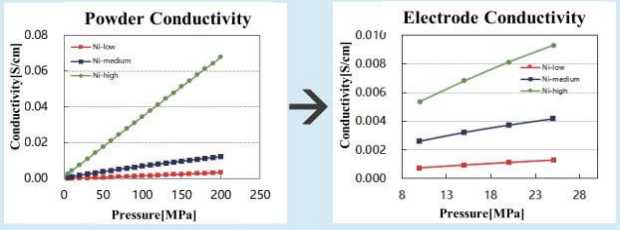
Results Analyze
By adjusting the Ni content in the ternary material, the powder conductivity increases with the increase of Ni content.
Compared with three kinds of ternary electrodes with different Ni content, the conductivity of the electrode increases with the increasing of Ni content;
Powder resistivity and electrode have the same trend !
3.NCMA material assessment (relation of powder resistivity and electrode: NCMA material)

Results Analyze
The conductivity trend of the Quaternary powder and electrode under three different modification conditions is NCMAT > NCMA-2 > NCMA-3 ;
The conductivity of NCMA43 in powder state is much smaller than that of the former two samples, but there is a small difference in the electrode plate, which may be related to the addition of conductive in the electrode plate, which reduces the difference between the powder.
Powder resistivity and electrode have the same trend !
4.LFP material assessment (relation of powder resistivity and electrode: LFP material)
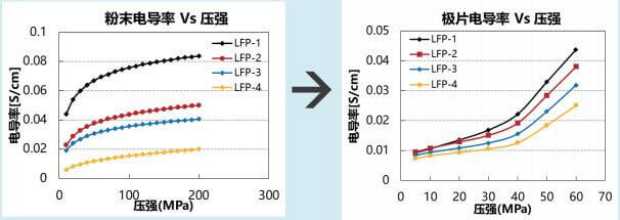
Results Analyze
Compared with the LFP powder and electrode sheet under four different modification conditions, the conductivity trend of LFP powder and electrode sheet is as follows
LFP-1>LFP-2>LFP-3>LFP-4
Powder resistivity and electrode have the same trend!
5.Graphite material assessment (compact density: parallel test 5 times)

Parameter: 20~200MPa, 20MPa steps, keep 30s, relief 3MPa steps, keep 10s
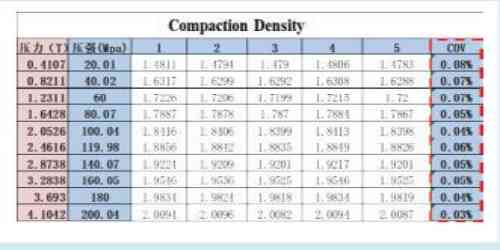
Results Analyze
The cov of five parallel samples is less than 0.1% in the whole pressure range, which indicates that the equipment has good repeatability.
With the increase of pressure, the Compact density of graphite material increases gradually and tends to be flat.
The rebound of powder thickness under pressure and pressure relief reaches the maximum value at 80MPa, which indicates that this condition is the maximum pressure that the powder can bear, and if it is too large, the material structure is likely to be damaged.
6.Carbon material assessment (compact density VS resistivity: parallel test 5 times)
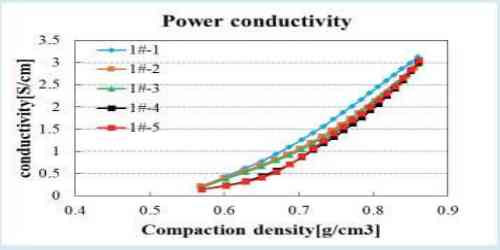
Parameter: relief mode: 10~200MPa, 10MPa steps, keep 10s Results: The cov of five parallel samples is less than 0.3% in the whole pressure range, which indicates that the equipment has good repeatability.
With the increase of pressure, the Compact density of carbon material increases gradually, and the compaction range is 0.5-0.9 g / cm3 .
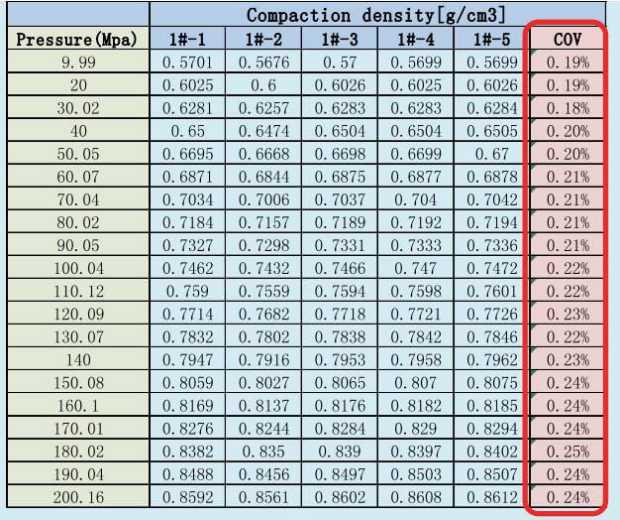
♦ Part of the data comes from the partners, and the copyright belongs to the relevant parties. It can not be reproduced or used without consent
High accuracy pressure system : Driven by servo motor.
High accuracy displacement sensor : Precisely measure the variation of thickness.
Specific clamp for resistivity & compaction density test of powder samples: Simplify the process of the powder loading and cleaning.
Multi-functions : One-stop data collection of key parameters of pressure, resistance, thickness, temperature and humidity with high reliability, to provide a complete traceability for each result.
Automatic measurement: Providing flexible measurement modes for different kinds of samples, and all the process parameter setting are integrated into a simple software control interface, with one-button to start a measurement.
PRCDMS Software:
1.Pressure can be set willfully within the extent of max pressure.
2.The resistivity under different pressure can be measured in succession with controllable rate and interval of pressure scan.
3.Different data analysis curves can be generated, including resistivity-pressure curve, resistivity-thickness curve, compaction density-pressure curve, and pressure-thickness curve.
4.Two resistance data collection modes: interval time mode or automatic steady state condition determine mode.
5.Data statistical analysis functions.
6.Automatic generation of reports with the value of resistivity (or conductivity) and Compaction density.
Integrated design : Integration of control and measurement systems for pressure, resistivity and thickness control and measurement systems.
Application fields
Carbonaceous Powders :
Active materials of Lithium Ion Batteries and various electronic components (capacitor and resistor; etc.), including graphite, activated carbon, coke, carbon black, carbon fiber; carbon nanoparticles, etc.
Metal oxide or metal composite powders:
Active materials of Lithium Ion Batteries, conductive pastes, conductive coatings and other functional films, including LCO, LMO, LFR NCM, LTO copper powder; ITO powder; etc.
|
Parameter |
|
|
Resistance range |
1uΩ-1200mΩ |
|
Resistance accuracy |
±0.05% |
|
Resistivity range |
10^(-6)Ω cm-10^9Ω cm |
|
Conductivity range |
10^(-9)^S/cm-10^6 S/cm |
|
Pressure range |
0-200 MPa |
|
Pressure accuracy |
±0.30%F.S |
|
Thickness range |
0-8 mm |
|
Thickness accuracy/resolution |
0.5um/±5um |
|
Max filling capacity |
Φ16*8 mm |
|
Temperature and humidity range |
20-90%RH, 0-50℃ |
|
Temperature and humidity accuracy |
±5%RH, ±2℃ |
|
Installation requirement |
|
|
Voltage |
220V |
|
Voltage change tolerance |
±10% |
|
Power consumption |
2100W |
|
Environment temperature |
25±5℃ |
|
Environmental humidity |
Humidity at 40℃ <80%RH |
|
Environmental magnetic field |
Away from intense electromagnetic fields |
|
Net weight |
165kg |
|
Dimension(W*D*H) |
370*580*1100 mm |
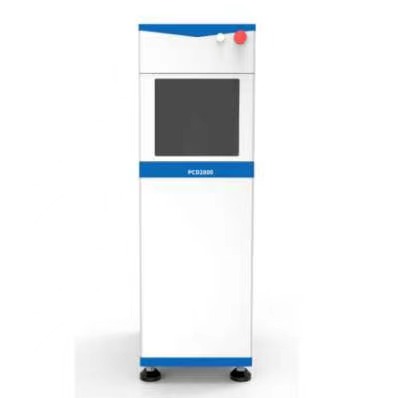



 Online service
Online service +86 13174506016
+86 13174506016 Louis@chinabatterymachine.com
Louis@chinabatterymachine.com +8613174506016
+8613174506016